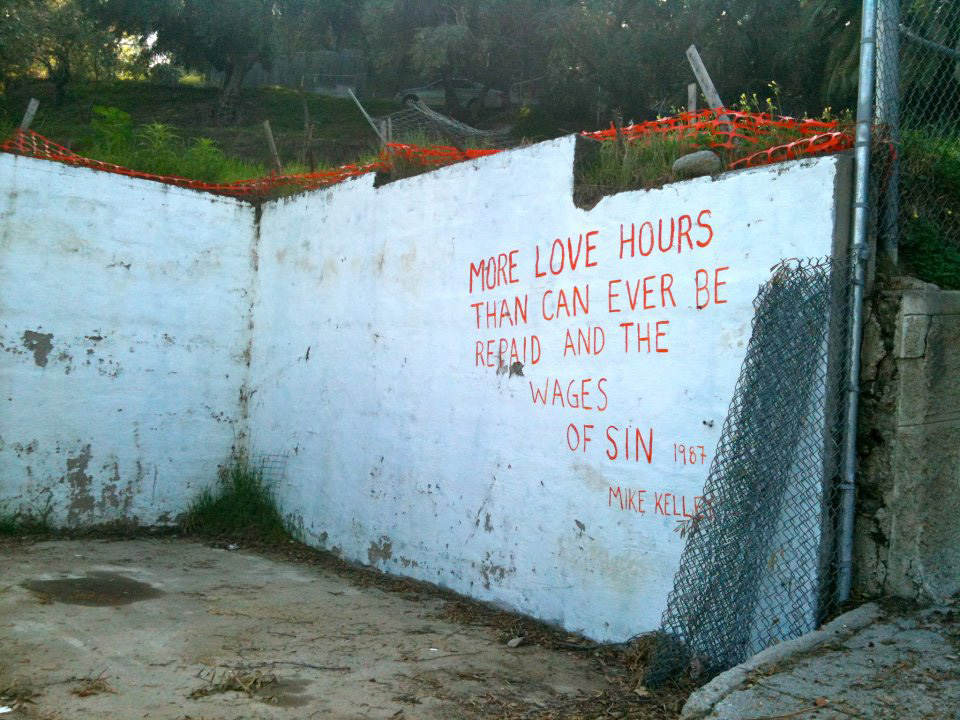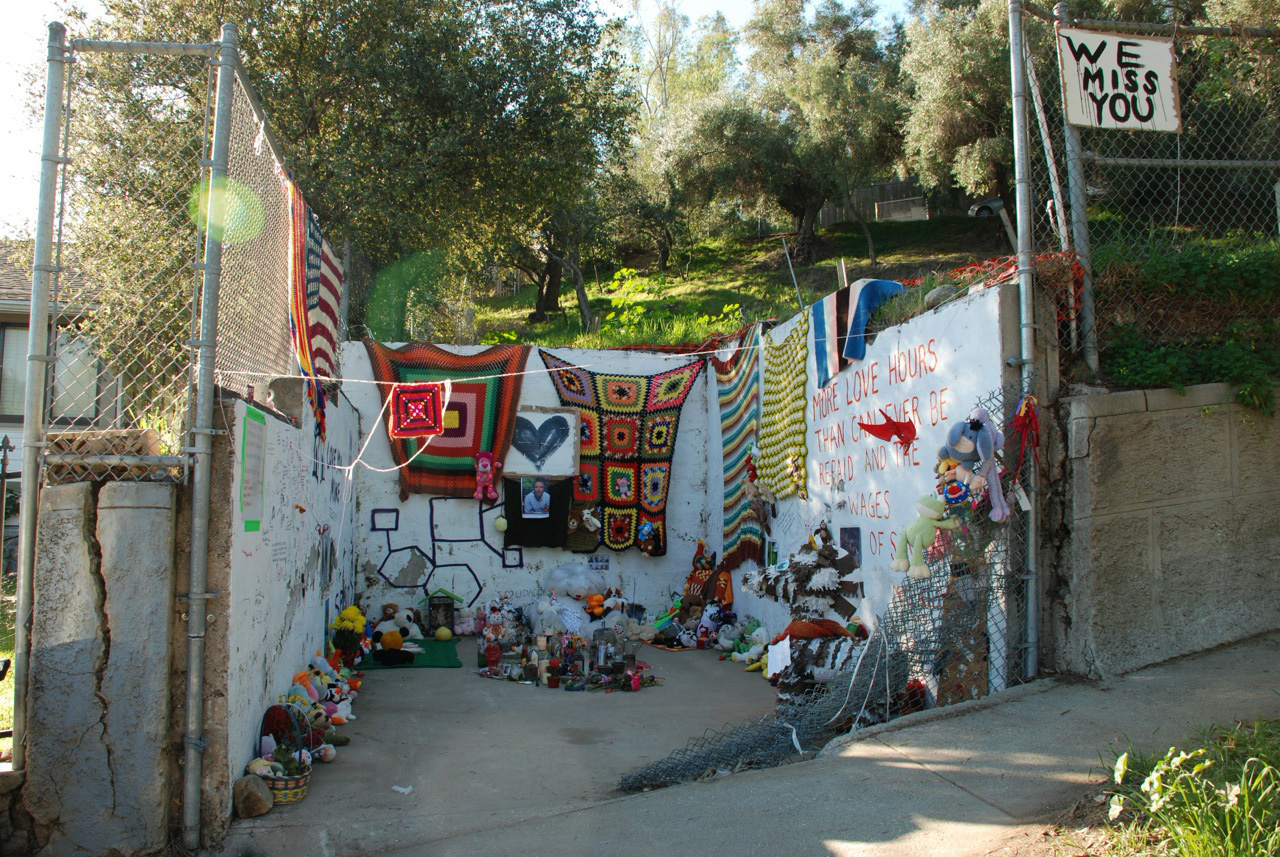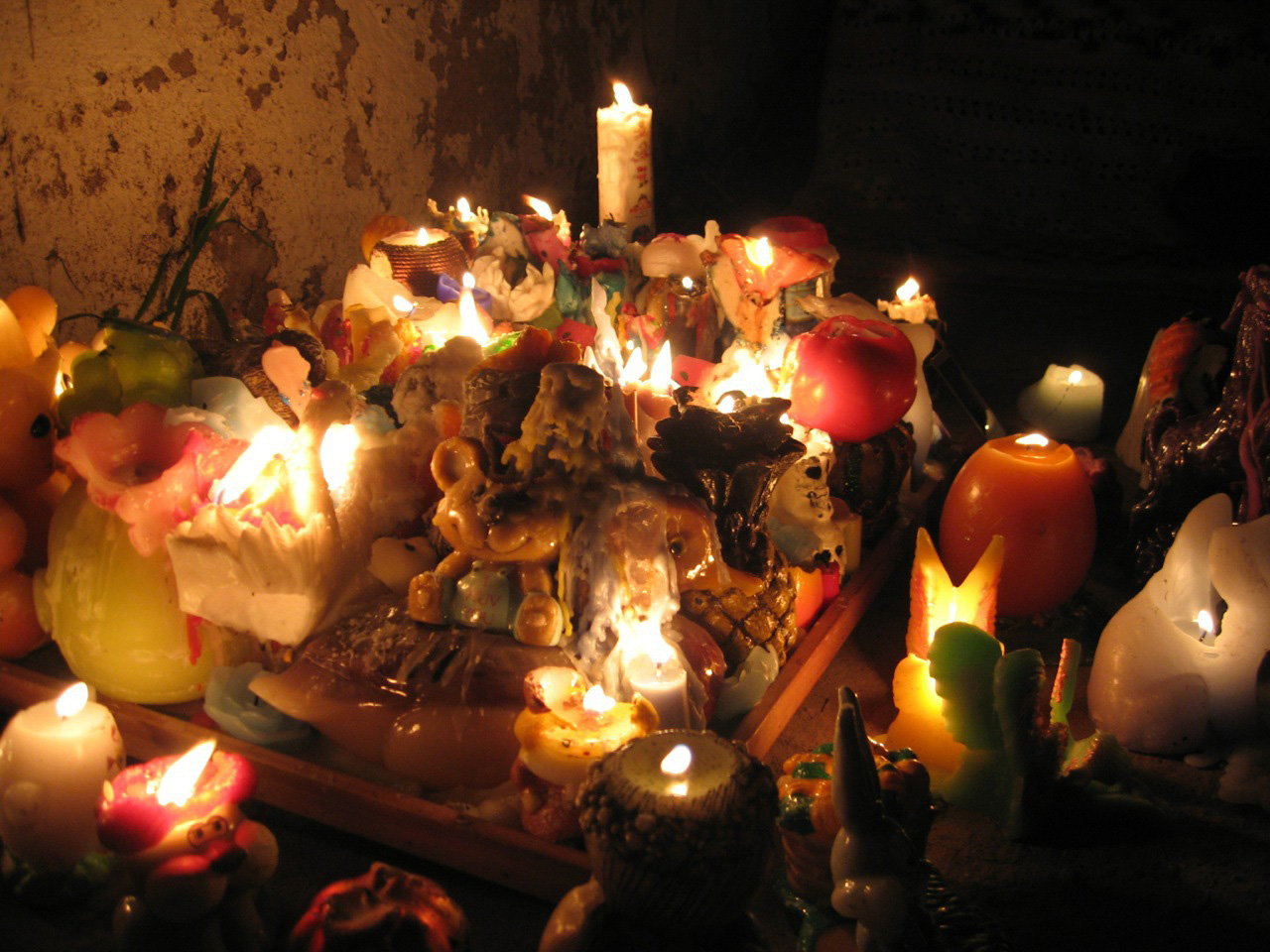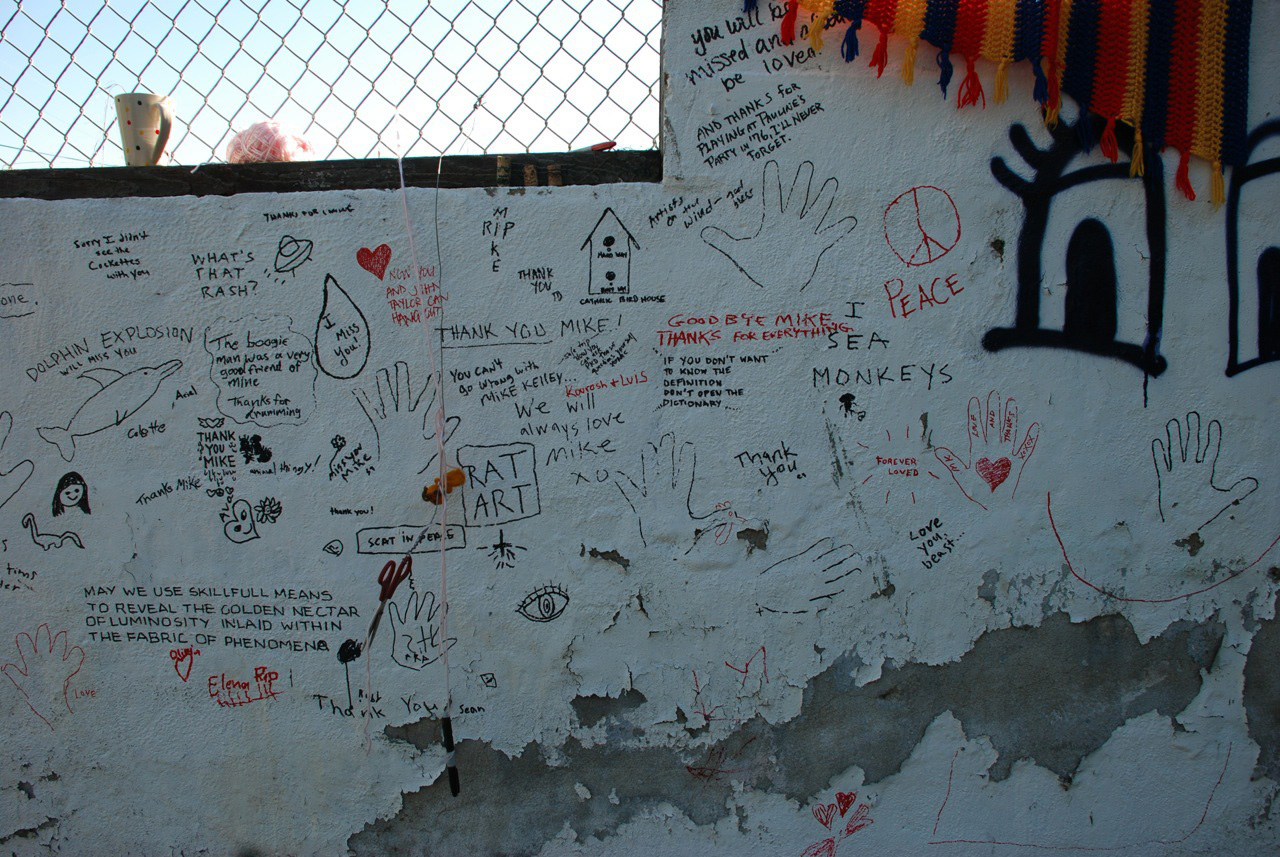At the End of Tipton Way: On the More Love Hours Memorial to Mike Kelley
by Jennifer Krasinski

The memorial site on February 1, 2012. All images courtesy of Mor Lovehours.
In the Highland Park neighborhood of Los Angeles, in an abandoned carport at one end of Tipton Way, a spontaneous memorial to the artist Mike Kelley bloomed soon after the news of his death, growing in the hours, days, and weeks that followed. A Facebook announcement created on February 1, 2012 by ‘Mor Lovehours’ invited all to “help rebuild MORE LOVE HOURS THAN CAN EVER BE REPAID AND THE WAGES OF SIN, 1987, by contributing stuffed fabric toys, afghans, dried corn, wax candles…building an altar of unabashed sentimentality.”1Hundreds of visitors answered the call, filling the space with these as well as other, more personal offerings:
I wanted to give something that had been loved and got my daughter to part with several stuffed animals, which I brought there, and left a glass bottle that we drank from and melted into a formless blob in the fire, remembering what Mike had told me about formlessness many times when he was my teacher.2
They Magic Markered farewell messages to him on the walls:
DEEP PEACE MIKE
LOVE YOU, MIKE
WE MISS YOU
We needed you
They burned sage, lit candles, drank beer, and smoked pot. They gathered and they mourned.
Many of my students who knew Mike’s work spent time there—it was good for them to have a place to go.

If it is human nature to try and contain grief—to give it an appropriate space so that it cannot wholly consume the living—the memorial on Tipton Way seemed to squarely capture the rush of outpourings of Kelley’s many friends, colleagues, former students, and fans. A gesture made by many hands, it was not a typical shrine: a place one goes to leave things behind, to lay things to rest. The carport was a space designated for creating and building, conceived in the spirit of the artist’s vocation and located just down the street from Kelley’s studio. Mourners doubled as makers, working in collaboration to build a tribute to what Kelley and his artwork meant to them. Beautifully, unwittingly, the memorial also grew into a powerful portrait of the community Kelley helped to form and then left behind.
One of the things I’ve been surprised at in the time since Mike Kelley’s death is the amount of times I’ve heard my artist peers say something to the effect of, “Oh, well, he’s the reason I knew I could/wanted to make art,” and “Oh, well, he’s the reason I left Sheboygan/Phoenix/Tallahassee, etc…to move to Los Angeles/go to Cal Arts.” I hadn’t ever really thought about any single pivotal moment when I steered my own trajectory as an artist so deliberately and as such a direct result of a specific individual’s influence. However, after hearing the above sentiment for the fourth time in three days, I realized that Kelley’s work had also been the linchpin of my transition to Los Angeles and a more serious investigation of contemporary art.
“Prowling the meanings of a word, prowling the history of a person, no use expecting a flood of light,” wrote poet Anne Carson in Nox, an elegy for her estranged brother about whose life she knew very little. For mourners who did not know Kelley personally, prowling his obituaries illuminated little, save the way in which a dazzling and complex life will be crammed into a pat, digestible form, presumably for the efficiency of the living. According to the many articles on Kelley, he was “an influential Los Angeles artist,” an “LA contemporary artist,” a “Los Angeles–based contemporary artist,” an “influential contemporary artist,” an “influential American artist,” “the California artist,” and, as well, “the daring and influential contemporary installation artist.” One also read as many times that he committed suicide at the age of 57 and was offered sound bites of conjectures as to why he—brilliant, successful, revered—took his own life.
For a man who was so articulate and so filled with conviction about the intention and meaning of his work to the degree that he insisted on writing about it himself when he found it misunderstood in the critical press, it seems so strange that he would be so silent in death. In life, he was filled with so many words, so much argument (in a good way, most of the time), and now, nothing.

Thus far left unprinted have been the darker murmurings of what has transpired in the wake of Kelley’s suicide: that Gagosian Gallery representatives let themselves into Kelley’s art studio the day after he died to rummage through what was there; that a prominent New York museum curator brought an uninvited celebrity art star as his guest to a memorial service held solely for Kelley’s nearest friends and family. Of course, rumors need not be true to possess some truth. Whether or not or how or why these events happened, the circulation of these stories testifies to a shared sentiment roiling beneath the LA art community’s grief: that financial interests have finally transformed the contemporary art world from a merely menacing force to an amoral, malignant one.
Mike emphasized what was missing in our surroundings…mostly by mentioning the connections implicit in our assumptions. We had to guess at what lack, what loss, wasn’t present but needed to be there, to complete the thought, image, or object of Mike’s practice. A framed sublime with the sublime missing, love that cannot be returned, the loss of self when we turn to prefabricated ideals, the can of Vernors that served as empty vessel for something else to happen. Mike gave a lot to an art world he cared about. That world changed from community, to the inevitable splintering of interests that is palpable when the art-fair booths go up, when value is found in monetary numbers, and when critique is directed at devaluing decisions rather than opening them up for consideration.
It is an important fact that he lived in Los Angeles because this city—like any city—plots grief in its own particular way. Having an airier reverence for the weights of history and permanence, this town is hardly a welcoming home for a monument. The ground here can’t be trusted to hold anything in place, and the perpetual sunshine numbs any conventional sense of the passing of time. So it is fitting that Kelley’s memorial would be ephemeral—here for a few weeks and ever changing—relying on presence and participation to mark his absence. Los Angeles is also a proud city, territorial and protective of itself, and very nearly jingoistic when fending off real or imagined challenges to its cultural virtues. And in this there was additional resonance in the re-creation of Kelley’s landmark work, More Love Hours Than Can Ever Be Repaid and the Wages of Sin (1987).3Not only did the choice honor the love hours Kelley spent over the course of his career as “the single most influential artist working in America,” but it also proved that there could be no remaking of Kelley’s art—no bringing him back to life—only an attempt to conjure the spirit in which he worked.4Somehow, too, at the risk of oversentimentality, the memorial seemed to call this piece back to Los Angeles from New York City, where its home for decades has been the Whitney Museum of American Art.
I won’t pretend to understand what the relationship might be between the original artwork and this tribute, but I know the shrine is not trying to mimic a work of art. As it grows, it’s simply offering a community of people who knew and admired Mike Kelley a place or way to show their respect. It lays bare the fact that Mike was loved, even if no one understood what he may have been going through.
I myself did not know Mike Kelley. I believe we shook hands once when introduced, but I can’t recall enough detail regarding the when and the where of our meeting to convince myself that my memory isn’t just a vivid wish or an overreaching regret. Once, I saw him dancing at The Echo. “There goes Mike,” someone said, smiling and pointing to the edge of the dance floor, and there he danced, his graceless arms and legs shooting from his body all at once. At that moment, he seemed absolutely possessed by life—by pure exuberance—and I remember thinking that his moves must have also been a show for some pretty women who were standing nearby, watching and giggling.

“All the girls came out to say goodbye,” I read on the wall at Tipton Way when I paid my last visit. “You are missed.” From a chain-link fence surrounding the carport hung a blanket crocheted to look like an American flag, through which I could see the silhouette of a palm tree. On another wall, I read the words Freakdom is love, and below, in smaller scrawl, a simple farewell: Bye, Mike.
No one was there for the 15 minutes that I was. I didn’t see anyone on the street. I added a candle and a small stuffed fish and relit all the candles, which was beautiful. I took pictures. I didn’t ever know Mike even though we crossed paths as he would have with anyone in the LA art community who also went to Art Center, but I never knew him. Maybe it’s even more shocking, unexpected for those who didn’t actually know him as a person, if you know what I mean.